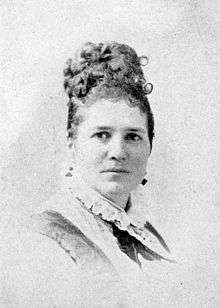Linda Gilbert
Linda Gilbert (13 May 1847 Rochester, New York – 24 October 1895 Mount Vernon, New York) was a prison reformer. Early in life, she became interested in efforts to improve the condition of prisons and prisoners, and endeavored “to remove the conditions that produce crime, by a wholesome system of industry and culture.” She succeeded in placing in various prisons libraries of from 1,500 to 2,000 volumes each, and aggregating 30,000 volumes.
Linda Gilbert | |
|---|---|
 | |
| Signature | |
Biography
At the age of 4, she moved with her family to Chicago, Illinois. She was educated there at St. Mary's Convent. Her home was opposite the jail of Cook County, Illinois. At the age of 11, she gave some books from her grandfather's library to the prisoners there. When she was 17, she established the first county-jail library there. At 15, she had inherited money. After spending $100,000 on philanthropy, the remainder was lost in a bank failure, and her philanthropic efforts required much more effort.
Gilbert developed several entrepreneurial projects as a source of funds for her philanthropic projects. She patented several devices, including a noiseless rail for railroads, and a wire clothes-pin, and established Linda Gilbert's Tax and Trade Record.
In 1876 the Gilbert Library and Prisoners' Aid Society was incorporated under the laws of the state of New York, and Gilbert became president of its board of managers. The objects of the Society were to improve prison discipline, to place libraries in every prison and jail in the country, to look after the prisoner's family if in need and worthy of aid, and to help convicts to lead upright lives after their discharge. Although lack of funds prevented the Society from doing any work after 1883, Gilbert continued to labor as an individual.
In all, she established 22 libraries in six states. In Lincoln, Nebraska, her books were a means of educating 18-20 Native Americans who were sentenced to long terms. She procured employment for 6,000 ex-convicts, over 500 of whom she started out as peddlers, furnishing them with outfits worth $3–$5; all this was accomplished with less than 10% recidivism. She felt society more responsible than the criminal for crime.
Notes
References
- Willard, Frances E.; Livermore, Mary A. (1893). A woman of the century. Moulton. p. 318.CS1 maint: ref=harv (link)
Attribution:
- This article incorporates text from a publication now in the public domain: Wilson, J. G.; Fiske, J., eds. (1900). . Appletons' Cyclopædia of American Biography. New York: D. Appleton.
External links
- Gilbert Library and Prisoners' Aid Society at britannica.com
- Biography and references at inthefirstperson.com